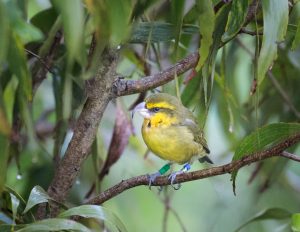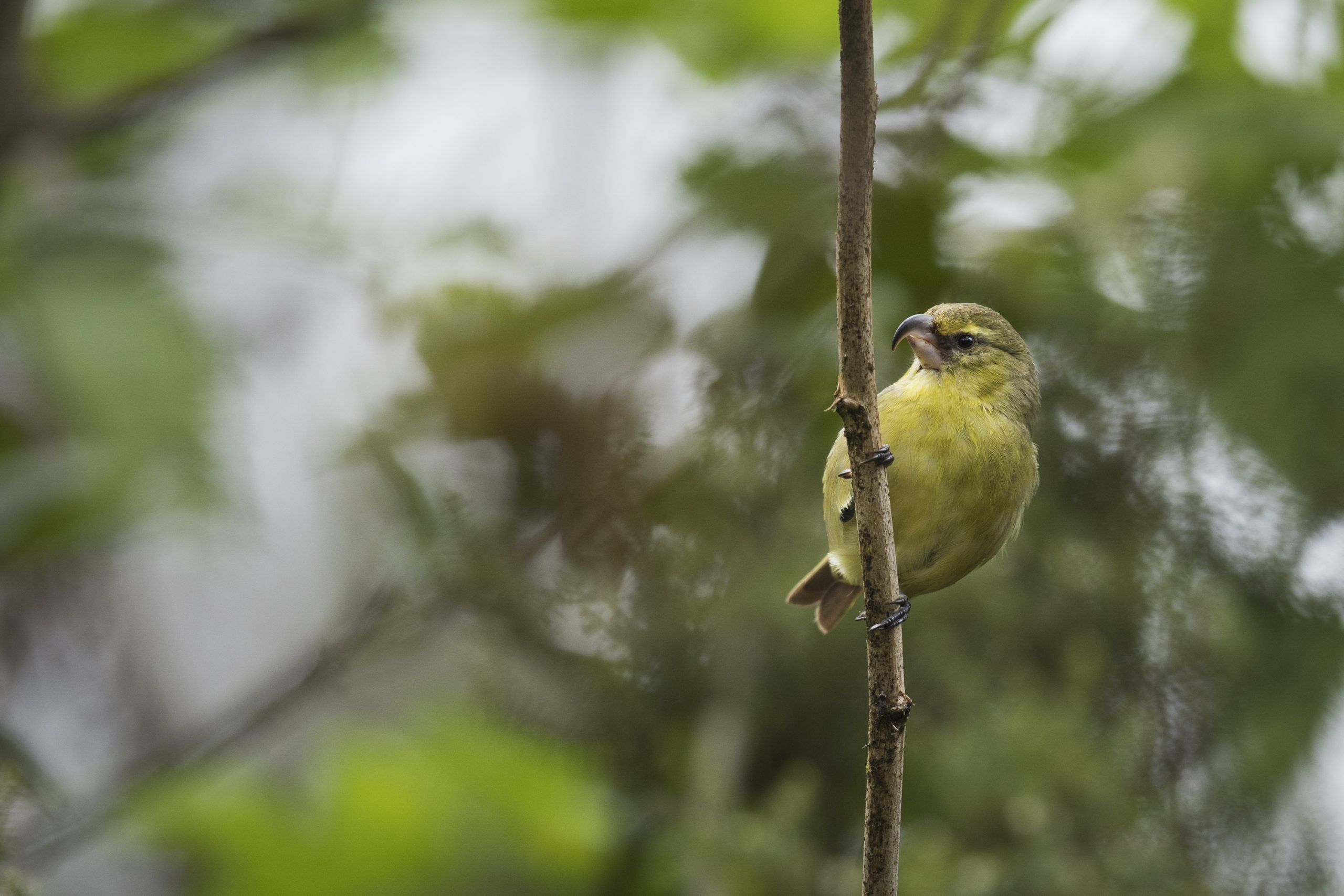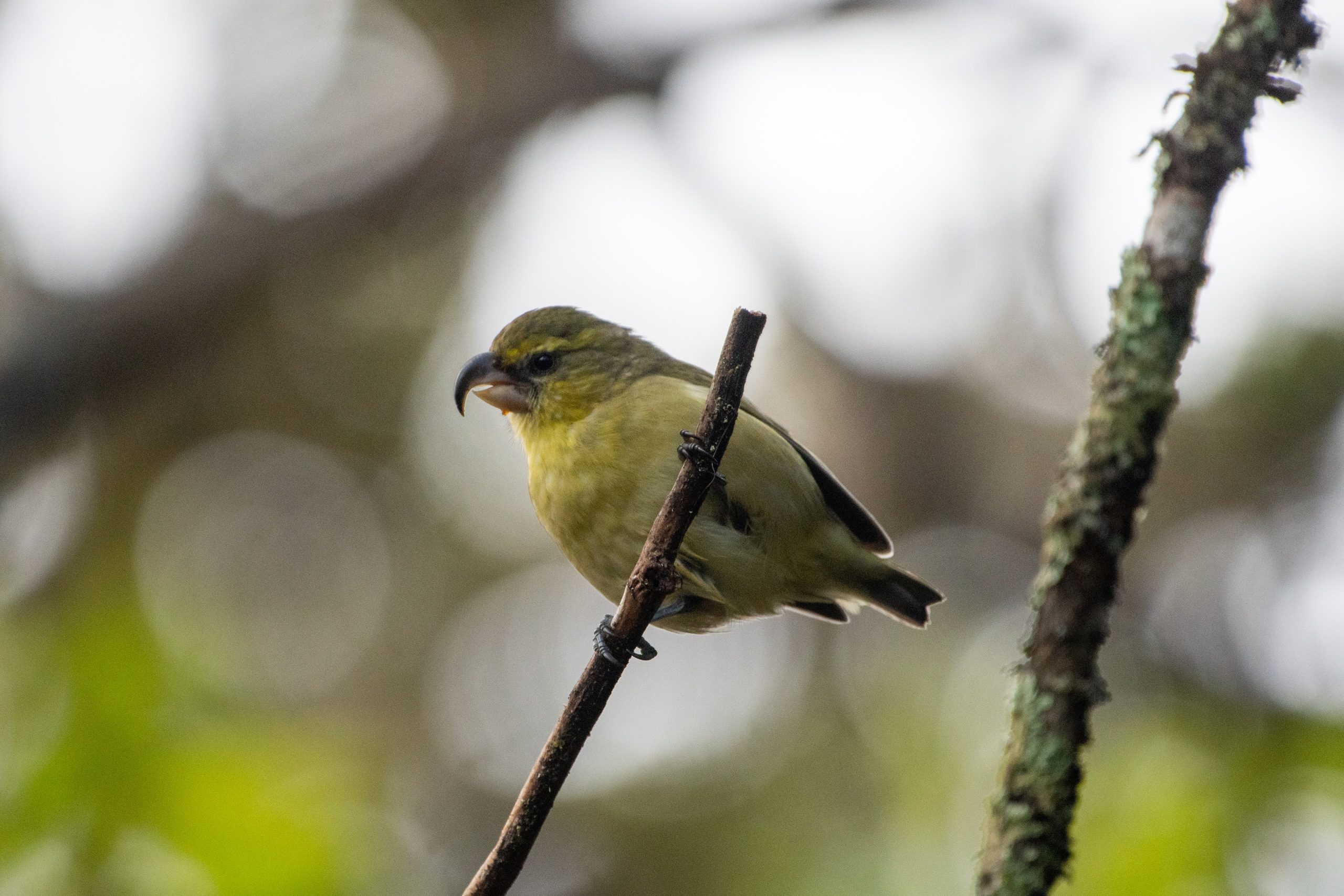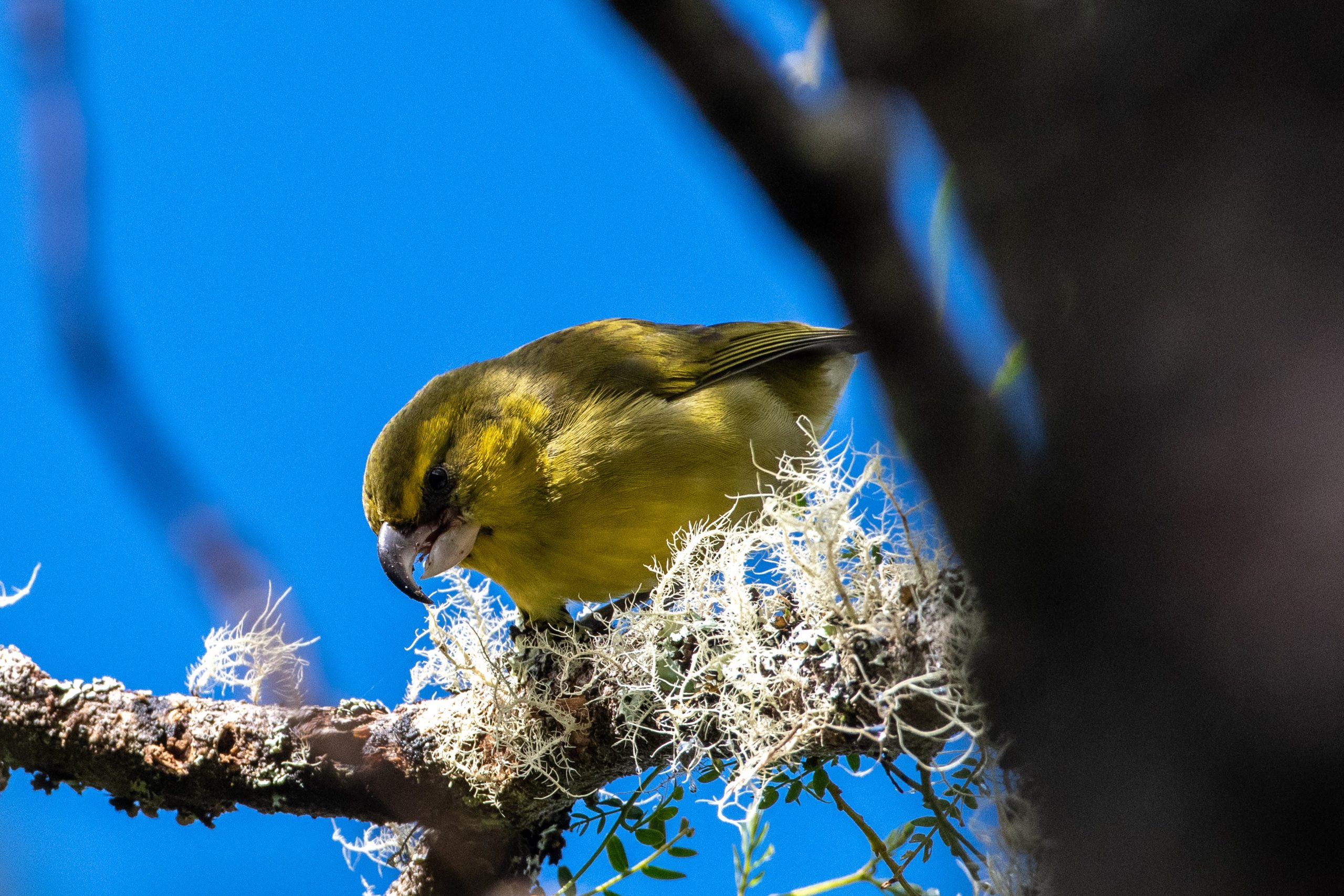Kiwikiu
Names
- ʻŌlelo Hawaiʻi: Kiwikiu
- Common: Maui Parrotbill
- Scientific: Pseudonestor xanthophrys
Song
Conservation Status
- Federally Listed as Endangered
- State Listed as Endangered
- State Recognized as Endemic
- NatureServe Heritage Rank G1—Critically Imperiled
- IUCN Red List Ranking— Critically Endangered
- Revised Recovery Plan for Hawaiian Forest Birds—USFWS 2006
Species Information

Kiwikiu or Maui Parrotbill. PC: Koa Matsuoka, San Diego Zoo Wildlife Alliance
The kiwikiu or Maui parrotbill is a stocky, endangered Hawaiian honeycreeper endemic to Maui, with a short tail and a relatively large, parrot-like bill. Adults are mostly olive-green above with a yellow breast, belly and cheeks, and a bright yellow line above their eyes (i.e., supercilium). Males are typically brighter than females, although individuals are variable. Males are significantly larger than females and have a larger bill. Kiwikiu are insectivores that feed on a variety of shrubs and small trees, especially ‘akala (Rubus hawaiensis), kanawao (Broussaisia arguta), ‘ōhi‘a (Metrosideros polymorpha), and koa (Acacia koa) where they glean prey from moss-covered branches or use their bill to chisel, crack, crush, dig, and tear bark and softer wood in search of beetle and Lepidoptera larvae and pupae. Kiwikiu will also open fruit in search of insects. Pairs defend relatively large (6-8 hectare), year-round home ranges. Females build nests, incubate eggs, and brood young. Clutch size is usually one, and females feed nestlings with food delivered by males. Males feed females and fledglings. Pairs will renest after a nest failure, but are not known to attempt another nest if the first is successful. Development of bill and acquisition of foraging techniques is lengthy and juveniles remain with parents for 5 to 18 months. Because of this long period of dependency, kiwikiu are often seen in small groups and males can be seen provisioning juveniles from current and previous years. The historical Hawaiian name for this bird was lost in history. The name Kiwikiu was created by the Hawaiian Lexicon Committee in 2010 (UH PCSU, 2021).
Distribution
Restricted to a ~30 square kilometer (11.5 square mile) area on the northeastern slopes of Haleakalā in east Maui between 1,525 and 2,370 meters (4,000 – 7,700 feet). Subfossils indicate they once occurred island-wide including at low elevations and leeward (southeastern) forests and on the island of Moloka‘i (UH PCSU, 2021).
Habitat
Currently found in upper-elevation montane wet forests dominated by ‘ōhi‘a, and in a few mesic areas dominated by ‘ōhi‘a and koa (Acacia koa), with a dense, diverse native understory and subcanopy of ferns, sedges, epiphytes, shrubs, and small to medium trees. Historic range thought to also include low and mid-elevation dry and mesic forest dominated by not only ʻ‘ōhi‘a, but also koa. Most of the current range is managed by the National Park Service, State of Hawai‘i, State of Hawaiʻi DLNR, and The Nature Conservancy (TNC) (UH PCSU, 2021).
Threats
- Low reproduction. Unlike many Hawaiian honeycreepers, kiwikiu have low annual fledgling production. This results from a low reproductive potential (one fledgling per year) coupled with low reproductive success due to habitat limitations and weather. This life history characteristic may be related to their very specialized foraging strategy. Regardless, the species is susceptible to factors that reduce population size.
- Disease. Kiwikiu, like other native Hawaiian honeycreepers, are highly susceptible to diseases transmitted by introduced mosquitoes, primarily the southern house mosquito (Culex quinquefasciatus). Although a large amount of suitable habitat exists it has been rendered almost completely uninhabitable to native birds (UH PCSU, 2021).
- Climate change. With the looming threat of climate change and projected temperature increases it is likely that there will be an increase in the amount of mosquitoes found within critical kiwikiu habitat (UH PCSU, 2021).
- Predation. Predation on birds and nests by rats (Rattus spp.), cats (Felis silvestris), and small Indian mongooses (Herpestes auropunctatus) may limit the species. High rat densities have been reported in the Hanawī area, which also supports a large proportion of the kiwikiu population (UH PCSU, 2021).
- Habitat loss. Historical accounts suggest that kiwikiu favored koa for foraging. Logging and ranching has resulted in the loss of large areas of dry and mesic koa forest, and their current range is restricted to wet forests where koa density is relatively low. Thus, kiwikiu, like many endangered Hawaiian forest birds, may be restricted to suboptimal habitat.
- Habitat degradation. Damage to understory vegetation by feral ungulates such as pigs (Sus scrofa), sheep, and deer, likely reduces habitat suitability and may contribute to reduced food availability and low reproductive success. Habitat degradation also may increase the exposure of nests to inclement weather.
- Population size. Small populations are plagued by a variety of potentially irreversible problems such as skewed sex ratios and genetic problems. Natural disasters and habitat fragmentation can also lead to demographic factors affecting population size (UH PCSU, 2021).
Explore from Home
Plans & Projects
Additional Resources
For more information and references visit the State Wildlife Action Plan factsheets. DOFAWʻs species pages and State Wildlife Action Plan fact sheets are provided for general information and are not meant to be a citable, original source of data. If you are a student, researcher, or writer looking for a citable source, please explore the references below or find other original data sources, rather than citing these webpages. The references below were provided by the authors of the State Wildlife Action Plan fact sheets at the time of drafting:
- Brinck KW, Camp RJ, Gorresen PM, Leonard DL, Mounce HL, Iknayan KJ, Paxton EH. 2012. 2011 Kiwikiu (Maui Parrotbill) and Maui Alauahio abundance estimates and the effect of sampling effort on power to detect a trend. Hawaii Cooperative Studies Unit, University of Hawaii at Hilo. Technical Report HCSU-035.
- IUCN Red List of Threatened Species. 2015. Version 2014.3. Available at: www.iucnredlist.org. (Accessed May 2015).
- Mounce HL, Leonard DL, Swinnerton KJ, Becker CD, Berthold LK, Iknayan KJ, Groombridge JJ. 2013. Determining productivity of Maui Parrotbills, an endangered Hawaiian honeycreeper. Journal of Field Ornithology 84(1):32-39.
- Mounce, HL, Iknayan, KJ, Leonard, DL, Swinnerton, KJ, and Groombridge, JJ. 2014. Management implications derived from long term re-sight data: annual survival of the Maui Parrotbill Pseudonestor xanthophrys. Bird Conservation International 24:316-326
- Mounce HL, Raisin C, Leonard DL, Wickenden H, Swinnerton KJ, Groombridge JJ. 2015. Spatial genetic architecture of the critically-endangered Maui Parrotbill (Psuedonestor xanthophrys): management considerations for reintroduction strategies. Conservation Genetics Volume 16, Issue 1: Page 71-84.
- Scott JM, Mountainspring S, Ramsey FL, Kepler CB. 1986. Forest bird communities of the Hawaiian islands: their dynamics, ecology and conservation. Lawrence, (KS): Cooper Ornithological Society.
- Simon JC, Baker PE, Baker H. 1997. Maui parrotbill (Pseudonestor xanthophrys). In The Birds of North America, No. 311 (Poole A, Gill F, editors.). Philadelphia, (PA): The Academy of Natural Sciences; and Washington DC: The American Ornithologists’ Union.
- Warren CW, Mounce HL. 2014. Home-range patterns of two Hawaiian honeycreepers, Kiwikiu (Pseudonestor xanthophrys) and Maui Alauahio (Paroeomyza montana). Presentation. Island Biology Conference, Honolulu, HI.
- U.S. Fish and Wildlife Service. 2006. Revised Recovery plan for Hawaiian forest birds. Portland, (OR): U.S. Fish and Wildlife Service.


 Saving Kiwikiu: Maui Parrotbill on the Brink
Saving Kiwikiu: Maui Parrotbill on the Brink 

